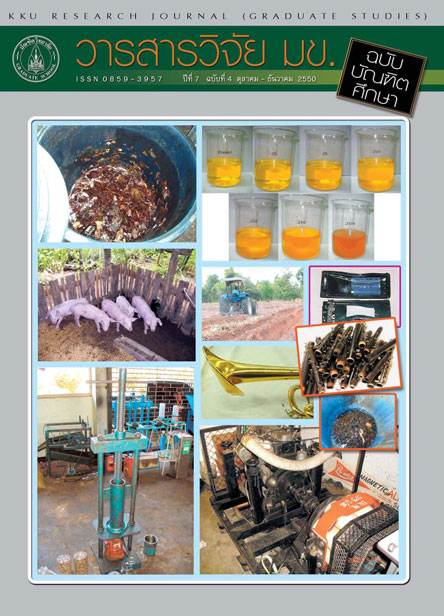The Value of Indigo Dyes in Capitalist Society(คุณค่าผ้าย้อมครามในกระแสทุน)
Keywords:
Indigo dyes(ผ้าทอย้อมคราม), Values(คุณค่า), Commodification(การทำให้เป็นสินค้าทางวัฒนธรรม)Abstract
การวิจัยนี้มีวัตถุประสงค์ เพื่อศึกษา พลวัตรการผลิตผ้าทอย้อมครามในกระแสทุกและคุณค่าผ้าทอย้อมครามในกระแสทุน โดยใช้การวิจัยเชิงคุณภาพ เก็บรวบรวมข้อมุลโดยวิธีการสัมภาษณ์แบบเจาะลึกโดยใช้เทคนิคการสัมภาษณ์แบบกึ่งโครงสร้าง และการสังเกตแบบมีส่วนร่วมและไม่มีส่วนร่วม กับ ผู้รู้ สมาชิกกลุ่มผ้าทอย้อมคราม ได้แก่ สมาชิกที่มีวัตถุดิบในการผลิต สมาชิกรับจ้างทอ และชาวบ้านทั่วไป ผลการศึกษา พบว่า กระบวนการผลิตผ้าทอย้อมคราม มีการเปลี่ยนแปลงไป จากอดีต ชาวบ้านผลิตเพื่อใช้ในครัวเรือน ใช้ปัจจัยการผลิตที่หาได้ในท้องถิ่น มีการออกแบบลวดลายเฉดสี และแปรรูปโดยคำนึงถึงประโยชน์ใช้สอยเป้นสำคัญ แต่ในปัจจุบันการผลิตเปลี่ยนมาเป้นการผลิเพื่อขายภายใต้การทำวัฒนธรรมให้เป็นสินค้า มีการกำหนดคุณภาพและผลิตภายใต้มาตรฐานเดียวกัน การแบ่งแยกแรงงานตามความชำนาญเฉพาะด้าน กำหนดราคา การโฆษณาประชาสัมพันธ์ รวมทั้งกำหนดลวดลาย เฉดสี แปรรูปผ้าทอย้อมความเพื่อสนองความต้องการของผู้บริโภค แต่ยังคงกระบวนการผลิตแบบดั้งเดิมเพื่อรักษาไว้เพื่อเป็นจุดขายของชุมชน และพบว่า ภายใต้กระแสทุนผ้าทอย้อมครามมีคุณค่าเปลี่นแปลงไปจากอดีตคือ 1)ด้านสังคมและวัฒนธรรม ในอดีต ชวนบ้านผลิตผ้าทอย้อมครามเพื่ใช้เป็นเครื่องนุ่งห่ม รวมทั้งใช้ห่อสมุนไพรเพื่อประคบบรรเทาอาการฟกช้ำ การผลิตผ้าทอย้อมครามมีผู้หญิงเป้นผู้ถ่ายทอดภูมิปัญญาผ่านวิธีการบอกเล่า และปฏิบัติให้เห้นจริง แนปัจจุบันชาวบ้านส่วนใหญ่ไม่ได้ผลิตผ้าทอย้อมคราม แต่ใช้สีเคมีสังเคราะห์ และนิยมซื้อเสื้อผ้าสำเร็จรูปมาสวมใส่ คุณค่าผ้าทอย้อมครามในด้านสังคมและวัฒนธรรมที่เปนวิถีชีวิตชาวบ้านจึงถูกลดความสำคัญลง 2)ด้านเศรษฐกิจ ชาวบ้านที่เป้นสมาชิกกลุ่มทอผ้าย้อมครามทำการผลิตเพื่อขา ทำให้ผ้าทอย้อมครามีมุลค่าแลกเปลี่ยน และการผลิตผ้าทอย้อมครามได้กลายเป้นอาชีพเสริมและ 3)ด้านสัญญะ ในอดีต ชาวบ้นผลิตผ้าทอย้อมครามเพื่อใช้ในชีวิตประจำวัน และสวมใปทำงานในไร่นาผ้าทอย้อมครามจึงมีสัญญะเป้นผ้าของชาวบ้าน จนมีคำกล่าวว่า "สีครามคือสีของชาวน้าผู้ต่ำต้อย" แต่ในปัจจุบันผ้าทอย้อมครามได้ถูกสร้างคุณค่าเชิงสัญญะผ่านกระบวนการผลิตที่แตกต่างไปจากอดีต โดยได้รับอิทธิพบมาจากกระแสธรรมชาตินิยม กระแสท้องถิ่นนิยม และนโยบายหนึ่งตำบลหนึ่งผลิตภัณฑ์ ผ้าทอย้อมครามจึงมีสัญญะที่แสดงความเป้นท้องถิ่น เป้นสินค้าและเครื่องแต่งกายประจำจังหวัดสกลนครเป้นผลิตภัณฑ์ที่ผลิตจากธรรมชาติ รวมทั้งเป้นงานศิลปหัตถกรรมที่มีลักษณะเฉพาะซึ่งบางผืนอาจมีเพียงชิ้นเดียวในดลก และการสร้างสัญญะเหล่านี้ส่งผลให้ผู้บริโภคใช้ผ้าทอย้อมครามโดยคำนึงถึงสัญญะที่กำกับอยู่มากกว่าสวมใส่โดยคำนึงถึงประโยชน์ใช้สอยโดยตรง
The objectives of this research were to study the dynamic production of indigo dyes in the capitalist society; and to investigate the value of such dyes. This research was qualitative in nature with data collected through semiûstructured and in-depth interviews as well as participatory and non - participatory observations. The informants consisted of resource persons, members of the Indigo Dyes Group, who owned raw materials and who was hired for weaving, and other local villagers. The result of the study indicated that the production of indigo dyes has been dynamically changed since its inception. In the past, villagers produced indigo dyes for their household use. Law materials could be obtained locally. The designs, color shades and products were produced according to the utilization. But, at present, the goal of production has changed from the past to commercial purposes. The production has been operated under the process of cultural commodification including quality determinant, production under the same standard, specialized division of labor, pricing, promoting of products, as well as using designs and colors shades in response to consumer needs. However, the original production process has to be maintained as the communityû selling point. As for the value of indigo dyes, this study found that under the capital led society the dynamic value of indigo dyes cover three aspects: 1) Socio-cultural aspect: in the past villagers produced indigo dyes for clothing and raping herbs to make heat pad for blur therapy. Moreover, the local belief in 'Mae Moh Nilé was reproduced in the production process. The wisdom of indigo dyes production has been transferred by women through retelling and practicing. Recently, however, most of villagers do not engage in indigo dyes. They rather use chemical dyes and ware ready-made cloths. Therefore, the socio-cultural value of indigo dyes, as villagersû way of life, has been declined. 2) Economic aspect: villagers, members of the Indigo Dyes Group, have produced for sale and therefore created exchange value of indigo dyes. This production has become a supplementary occupation; and 3) Symbolic aspect: in the past, villagers produced indigo dyes for daily use including cloths for wearing when work in the rice field. Therefore, this cloth became symbol of villagers and there was a saying: çIndigo is the color of poor rice growers.é At present days, symbolic value of indigo dyes was constructed through the production process which is different form that of the past. This current process has influenced by naturalism, localism, as well as the One-Tambol-One-Product policy. Then, indigo dyed cloth symbolize locality, products and dresses of Sakonnakhon Province, natural products, and the unique handicrafts; some of which is the only piece in the world. The construction of this symbolic value has influenced the consumers to use up the indigo dyed products by considering their embedded symbolic value, rather than their use value.



